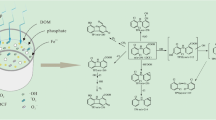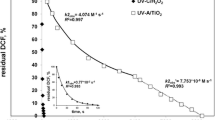Abstract
Diclofenac (hereafter DCF) is an extensively used anti-inflammatory drug; therefore, it is found in many sewage treatment plant effluents and it is one of the most usually reported environmental pharmaceutical contaminants. In this work, the degradation of diclofenac in pure water under UV light was studied, and the influence of some variables, such as humic acids (HA), nitrate anions (NO3 −) and titanium dioxide (TiO2) on DCF photodegradation was investigated. The experimental activity was carried out in a batch reactor of 100 mL equipped with fixed UV light of 254 nm and an irradiation intensity of 400 mJ/m2. Diclofenac initial concentration was equal to 10 mg/L in pure water, and its removal was evaluated by varying HA concentration in the range 10–20 mg/L and NO3 − concentration in the range 25–50 mg/L. Furthermore, the heterogeneous catalysis with TiO2 (1–50 mg/L) was studied. Temperature in all experiments was kept constant at 20 °C. Experimental results show that while HA have a significant influence on DCF photodegradation, nitrate and titanium dioxide seem to be ineffective, at least in the tested conditions. Finally, DCF photolysis modelling was carried out and a pseudo-first-order kinetic model was used.








Similar content being viewed by others
References
Andreozzi, R., Marotta, R., & Paxéus, N. (2003). Pharmaceuticals in STP effluents and their solar photodegradation in aquatic environment. Chemosphere, 50, 1319–1330.
Artinger, R., Buckau, G., Geyer, S., Fritz, P., Wolf, M., & Kim, J. I. (2000). Characterization of groundwater humic substances: influence of sedimentary organic carbon. Applied Geochemistry, 15, 97–116.
Bortone, I., Di Nardo, A., Di Natale, M., Erto, A., Musmarra, D., & Santonastaso, G. F. (2013). Remediation of an aquifer polluted with dissolved tetrachloroethylene by an array of wells filled with activated carbon. Journal of Hazardous Materials, 260, 914–920.
Bound, J., & Voulvoulis, M. (2005). Household disposal of pharmaceuticals as a pathway for aquatic contamination in United Kingdom. Environmental Health Perspectives, 113(12), 1705–1711.
Buxton, G. V., Mulazzani, Q. G., & Ross, A. B. (1995). Critical review of rate constants for reactions of transients from metal ions and metal-complexes in aqueous solution. Journal of Physical and Chemical Reference Data, 24, 1055–1349.
Cabot, J. M., Fuguet, E., & Rosés, M. (2014). Determination of acidity constants of sparingly soluble drugs in aqueous solution by the internal standard capillary electrophoresis method. Electrophoresis, 35(24), 3564–3569.
Canonica, S., Jans, U., Stemmler, K., & Hoignee, J. (1995). Transformation kinetics of phenol in water: photosensitization by dissolved natural organic material and aromaticketones. Environmental Science and Technology, 29, 1822–1831.
Capocelli, M., Prisciandaro, M., Lancia, A., & Musmarra, D. (2014a). Chemical effect of hydrodynamic cavitation: simulation and experimental comparison. AICHE Journal, 60, 2566–2572.
Capocelli, M., Prisciandaro, M., Lancia, A., & Musmarra, D. (2014b). Hydrodynamic cavitation of p-nitrophenol: a theoretical and experimental insight. Chemical Engineering Journal, 254, 1–8.
Chianese, S., Iovino, P., Canzano, S., Prisciandaro, M., & Musmarra, D. (2016). Ibuprofen degradation in aqueous solution by using UV light. Desalination and Water Treatment, 57, 22878–22886.
Erto, A., Bortone, I., Di Nardo, A., Di Natale, M., & Musmarra, D. (2014). Permeable Adsorptive Barrier (PAB) for the remediation of groundwater simultaneously contaminated by some chlorinated organic compounds. Journal of Environmental Management, 140, 111–119.
Fatta-Kassinos, D., Vasquez, M. I., & Kümmerer, K. (2011). Transformation products of pharmaceuticals in surface waters and wastewater formed during photolysis and advanced oxidation processes—degradation, elucidation of byproducts and assessment of their biological potency. Chemosphere, 85, 693–709.
Gao, H., & Zepp, R. G. (1998). Factors influencing photoreactions of dissolved organic matter in a coastal river of the southeastern United States. Environmental Science and Technology, 32, 2940–2946.
Georgaki, I., Vasilaki, E., & Katsarakis, N. (2014). A study on the degradation of carbamazepine and ibuprofen by TiO2 & ZnO Photocatalysis upon UV/visible-light irradiation. American Journal of Analytical Chemistry, 5, 518–534.
Giri, R. R., Ozaki, H., Ota, S., Takanami, R., & Taniguchi, S. (2010). Degradation of common pharmaceuticals and personal care products in mixed solutions by advanced oxidation techniques. International journal of Environmental Science and Technology, 7(2), 251–260.
Haag, W. R., & Hoignee, J. (1986). Singlet oxygen in surface waters. 3. Photochemical formation and steady-state concentrations in various types of waters. Environmental Science and Technology, 20, 341–348.
Iovino, P., Canzano, S., Capasso, S., Erto, A., & Musmarra, D. (2015). A modeling analysis for the assessment of ibuprofen adsorption mechanism onto activated carbons. Chemical Engineering Journal, 277, 360–367.
Iovino, P., Chianese, S., Canzano, S., Prisciandaro, M., & Musmarra, D. (2016a). Degradation of ibuprofen in aqueous solution with UV light: the effect of reactor volume and pH. Water, Air & Soil Pollution, 227, 194.
Iovino, P., Chianese, S., Canzano, S., Prisciandaro, M., & Musmarra, D. (2016b). Ibuprofen photodegradation in aqueous solutions. Environmental Science and Pollution Research, 23, 22993–23004.
Iovino, P., Chianese, S., Canzano, S., Prisciandaro, M., & Musmarra, D. (2017). Photodegradation of diclofenac in wastewaters. Desalination and Water Treatment, 61, 293–297.
Kanakaraju, D., Motti, C. A., Glass, B. D., & Oelgemoller, M. (2014). Photolysis and TiO 2-catalysed degradation of diclofenac in surface and drinking water using circulating batch photoreactors. Environmental Chemistry, 11, 51–62.
Kim, S., & Aga, D. (2007). Potential ecological and human health impacts of antibiotics and antibiotic-resistant bacteria from wastewater treatment plants. Journal of Toxicology and Environmental Health, Part B, 10(8), 559–573.
Koumaki, E., Mamais, D., Noutsopoulos, C., Nika, M. C., Bletsou, A. A., Thomaidis, N. S., Eftaxias, A., & Stratogianni, G. (2015). Degradation of emerging contaminants from water under natural sunlight: the effect of season, pH, humic acids and nitrate and identification of photodegradation by-products. Chemosphere, 138, 675–681.
Lee, E., Shon, H. K., & Cho, J. (2014). Role of wetland organic matters as photosensitizer for degradation of micropollutants and metabolites. Journal of Hazardous Materials, 276, 1–9.
Leone, V., Canzano, S., Iovino, P., & Capasso, S. (2012). Sorption of humic acids by a zeolite-feldspar-bearing tuff in batch and fixed-bed column. Journal of Porous Materials, 19, 449–453.
Leone, V., Musmarra, D., Iovino, P., & Capasso, S. (2017). Sorption equilibrium of aromatic pollutants onto dissolved humic acids. Water, Air & Soil Pollution, 228, 136.
Lopez, A., Bozzi, A., Mascolo, G., & Kiwi, J. (2003). Kinetic investigation on UV and UV/H2O2 degradations of pharmaceutical intermediates in aqueous solution. Journal of Photochemistry and Photobiology A: Chemistry, 156(1–3), 121–126.
Mazziotti di Celso, G., & Prisciandaro, M. (2013). Wastewater reuse by means of UF membrane process: a comparison with Italian provisions. Desalination and Water Treatment, 51, 1615–1622.
Musmarra, D., Prisciandaro, M., Capocelli, M., Karatza, D., Iovino, P., Canzano, S., & Lancia, A. (2016). Degradation of ibuprofen by hydrodynamic cavitation: reaction pathways and effect of operational parameters. Ultrasonics Sonochemistry, 29, 76–83.
Prisciandaro, M., & Mazziotti di Celso, G. (2016). On the removal of natural organic matter from superficial water by using UF and MF membranes. Desalination and Water Treatment, 57, 2481–2488.
Prisciandaro, M., Capocelli, M., Piemonte, V., & Barba, D. (2016). Process analysis applied to water reuse for a “closed water cycle” approach. Chemical Engineering Journal, 304, 602–608.
Rivera-Utrilla, J., Sánchez-Polo, M., Ferro-García, M. A., Prados-Joya, G., & Ocampo-Pérez, R. (2013). Pharmaceuticals as emerging contaminants and their removal from water. A review. Chemosphere, 93, 1268–1287.
Stangroom, S. J., MacLeod, C. L., & Lester, J. N. (1998). Photosensitized transformation of the herbicide 4-chloro-2-methyl-phenoxy acetic acid (MCPA) in water. Water Research, 32(3), 623–632.
Tortora, F., Innocenzi, V., Prisciandaro, M., Vegliò, F., & Mazziotti di Celso, G. (2016). Heavy metal removal from liquid wastes by using Micellar-Enhanced Ultrafiltration. Water, Air, & Soil Pollution, 227(7). doi:10.1007/s11270-016-2935-7.
Tortora, F., Innocenzi, V., Prisciandaro, M., De Michelis. I., Vegliò, F., & Mazziotti di Celso, G., (2017) Removal of tetramethyl ammonium hydroxide from synthetic liquid wastes of electronic industry through micellar enhanced ultrafiltration. Journal of Dispersion Science and Technology1-7. doi:10.1080/01932691.2017.1307760.
Yuan, F., Hu, C., Hu, X., Qu, J., & Yang, M. (2009). Degradation of selected pharmaceuticals in aqueous solution with UV and UV/H2O2. Water Research, 43, 1766–1774.
Author information
Authors and Affiliations
Corresponding author
Rights and permissions
About this article
Cite this article
Chianese, S., Iovino, P., Leone, V. et al. Photodegradation of Diclofenac Sodium Salt in Water Solution: Effect of HA, NO3 − and TiO2 on Photolysis Performance. Water Air Soil Pollut 228, 270 (2017). https://doi.org/10.1007/s11270-017-3445-y
Received:
Accepted:
Published:
DOI: https://doi.org/10.1007/s11270-017-3445-y




